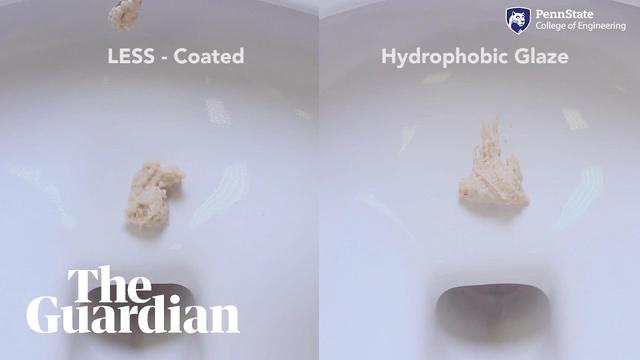Scientists develop slippery toilet coating to stop poo sticking
The toilet brush need never leave its holder again. Scientists have created a super-slippery coating that helps usher excrement on its way without leaving traces behind.
The spray-on coating, which is slipperier than Teflon, reduces adhesion of even tenacious faeces by up to 90%, tests suggest, so far less water is needed to flush them away and leave the toilet clean.
Researchers at Penn State University believe the coating could slash household water consumption and prevent odours and disease-causing germs from building up in toilets.
“I was very happy to see how easily the faecal matter slid off our coated surface,” Tak-Sing Wong at Penn State University told the Guardian.
Wong became interested in soiled toilets in 2015 when researchers at Cranfield University contacted him for help. They were designing a toilet for use in the developing world, but found that odorous waste built up on the toilet bowl surface. “My research group was known for developing highly slippery coatings to repel sticky substances,” Wong explained.

He and his team spent the next few years developing a coating they call a “liquid entrenched smooth surface”, or Less. It has two parts. The base layer binds to the toilet bowl and has protruding “nanohairs”, each one a billion times thinner than a human hair. To this they add a fine coating of silicone oil, which is held in place by the base layer. In all, the coating takes less than five minutes to apply.
Having devised the coating, the researchers were keen to learn whether it worked. And so began a series of eye-opening tests. For the first they turned to a South African recipe for synthetic faeces and knocked up a batch of different consistencies. To mimic faecal freefall, they dropped samples from a height of 40cm on to test plates angled at 45 degrees. Then, with help from a fluorescent dye mixed into the material, they measured how much water it took to dislodge the fake faeces and remove any visible marks. The coated surface took 90% less water to clean than glass sheets, the scientists found.
Next, the researchers built a rig that dropped real human faeces – sourced from three anonymous donors – on to a horizontal plate made of toilet ceramic, teflon, silicone, or the scientists’ coating. Once falling faeces had settled on the plate, the researchers released the platform so that it swung down like a trapdoor, and watched to see what happened.
Writing in the journal Nature Sustainability, Wong, who has co-founded a company to sell the coating, describes how all of the comparison surfaces displayed “extreme stickiness” to the faeces, while the Less coating appeared to shed its load cleanly.
Further tests showed that the scientists’ coating was better than conventional toilet surfaces at preventing bacteria from faeces, urine or even rainwater from growing in the bowl. While the coating was stable enough to withstand 500 flushes, one test that simulated urination found that it might need replenishing after 50 “urination cycles”.
More than 141bn litres of fresh water are used to flush toilets each day, or nearly six times the daily water consumption of Africa, Wong said. With millions around the world facing severe water scarcity, he said he hoped that reducing the amount of water used for flushing could help to alleviate the problem.
“People will be familiar with the effectiveness of non-stick frying in their lives, and a similar approach to solving the problem of stickiness is behind this ingenious piece of materials science. This time the problem is not eggs sticking to a cooking pan, but poo sticking to the toilet pan,” said Mark Miodownik, professor of materials and society at UCL.
“As this paper shows, such toilets would need less water per flush to clean them and also increase toilet hygiene. My one worry, which I’m sure the scientists will address as they do further work, is what happens to the coating when it does wear away through use – how would chemicals involved affect the environment if adopted globally?”








